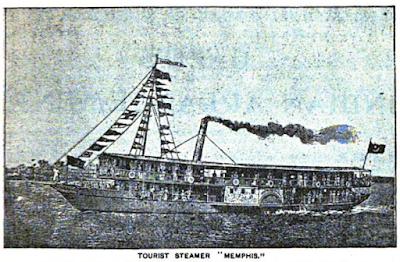In a previous post (see “Letters from Pharaoh’s Land, Part I,” December 1, 2015), I outlined a brief history of tourism on the Nile River in the late nineteenth-century and indicated that Dr. Freeman Allen, future husband of Mary Ethel Gibson, took a cruise there in 1895. By the late decades of the nineteenth-century, American and European tourists regularly vacationed in Egypt, staying in luxurious hotels, visiting local markets, exploring archaeological sites, and—thanks to the services of businesses like Thomas Cook and Sons and the Thewfikieh Nile Navigation Company—cruising the Nile River. In this, the second part of a two-part post on Nile River cruises, we discuss Dr. Allen’s 1895 cruise—adding a more personal dimension to our story of late-nineteenth-century Egyptian tourism.
Starting
out from Cairo on January 22, Dr. Allen travelled up the Nile on board the S.S. Memphis,
a steamship with a carrying capacity of forty passengers. For the next three
weeks, he and his fellow passengers divided their time between the activities
available on ship and exploring local sites of historical interest. “You go up
the Nile on a steamer with about 40 people and stop every day to take long
donkey or camel rides to examine the magnificent ruins of temples . . . which
are very frequent along the banks,” he wrote to Mary Ethel late into his trip.
In
his letters, Dr. Allen devoted a few lines to describing the other passengers.
While there was a “very nice and congenial crowd aboard this boat,” he lamented
that there were “too many old maids. They are by far the majority.” But among
the “nice and congenial crowd” there were several young girls, a “sporty[,]
young” married couple with a boy, and the two Martin sisters, who were rather
“intellectual.” Apparently the two sisters fancied themselves archaeologists,
for they often spent “entire afternoon[s] deciphering the hieroglyphics on the
columns” of various sites.
 |
| Columns at Karnak Temple Complex, 1905 |
From
his letters, it appears Dr. Allen got along well with the young married couple
and the Martin sisters. They would visit local ruins together, ride along the
river together, and pass the nights together on deck. “One night the Misses
Martin and the young married people and I sat up late talking and had a bully
time. The young married lady smoked the festive cigarette, which scandalized
the highly erudite Misses Martin.” Although Dr. Allen doesn’t explain what made
the cigarette so “festive,” an earlier reference suggests it might have been hashish.
He
seemed particularly amused by the young married woman. They often gossiped
together during the trip. “She would talk like a machine when she got going.”
But it was her preference for the chaise à
porteur—a sedan chair—over donkey rides that most amused him. Rather than
ride a donkey to that day’s attraction, as the other passengers did, she was
carried in her chaise à porteur by
four Arab men.
 |
| Temple of Isis on the Island of Philae, 1890 |
While the S.S. Memphis group would have visited dozens of sites along the way, there were only a few that Dr. Allen mentioned, suggesting that he might have been particularly struck by them. These included the Karnak temple complex near Luxor, the Temple of Isis on the island of Philae, and the Temple of Deir el-Bahri, also as Luxor. At Deir el-Bahri he went into a tomb being excavated and tore off a strip of mummy cloth, which he later mailed to Mary Ethel. (She kept the mummy cloth in its original envelope, and it is currently in our collection of Dr. Allen's letters at the museum.)
 |
| Assouan (Aswan) and the Cataract Hotel, 1906 |
Two
weeks into the cruise, the S.S. Memphis
reached Aswan, turned around, and headed back to Cairo, arriving a week later. There
was much about his trip that Dr. Allen seems to have enjoyed, but one passage
from a letter dated February 6 suggests that he was particularly impressed by
the sunsets. “No pictures that you ever have seen of Oriental sunsets are
exaggerated; not even the most florid and impossible seeming ones. The sun is
just setting now, but the wonderful colors don’t begin till about ½ hour after
the old feller gets beneath the horizon.”
By
Timothy Spezia, museum docent
Image Sources:
S.S. Memphis: "Gaze's Nile Tours: Winter 1895 and Spring 1896," Gaze's Tourists Gazette 8, no. 2 (December 1895), p. 67.
Karnak columns: From Travelers in the Middle East Archive (TIMEA). https://scholarship.rice.edu/handle/1911/21013
Temple of Isis: From Travelers in the Middle East Archive (TIMEA). https://scholarship.rice.edu/handle/1911/21372
Assouan and the Cataract Hotel: From Travelers in the Middle East Archive (TIMEA). https://scholarship.rice.edu/handle/1911/20952
Sources:
Freeman Allen to Mary Ethel Gibson, letters, January--February 1895.
"Gaze's Nile Tours: Winter 1895 and Spring 1896," Gaze's Tourists Gazette 8, no. 2 (December 1895), pp. 64--67.


No comments:
Post a Comment